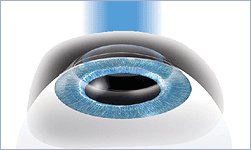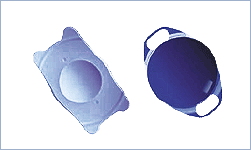Message From Jordan Kassoff, M.D.
I have a conservative approach to refractive surgery. My patients' safety and their satisfaction with both their results and their care are my prime concerns. As a fellowship-trained refractive surgeon, I believe that refractive surgery should be taken seriously by the patient and the doctor. In this regard, I personally conduct my patients' entire pre- and post- operative examinations.
I understand the importance of establishing a quality doctor-patient relationship from the outset. It is important that I clearly understand each patient's motivations and expectations and will have the necessary discussions to accomplish this. I will take the time to carefully go over the informed consent, including the risks, benefits, alternatives, and to answer all of your questions. In order to diminish the chances of having complications in both eyes, I perform surgery for each eye on different days. I feel strongly that the risks taken for each eye should be separated.
If you would like to see me to pursue your interest in refractive surgery please call the office at 518-434-1042 x 3 for further information or to set up an evaluation.
Jordan Kassoff, MD
Message From Rahul Patel, M.D.
I have extensive experience in both LASIK and ASA (Advance Surface Ablation). Both procedures reshape the surface of the cornea, the front window of the eye, to reduce or eliminate the need for glasses and contact lenses. Outcomes are similar for both techniques, and I recommend the technique based on the initial preoperative consultation which I perform myself. In order to determine which is the best technique to correct your vision, a thorough evaluation is required. This evaluation includes not only an assessment of your visual needs and activities, but also multiple diagnostic tests that assess factors such as the shape and thickness of your cornea. The purpose of this testing is to ensure the safety of any procedure being considered.
If you are interested in Laser vision correction, contact our office at 518-434-1042 x 3.
Sincerely,
Rahul Patel, M.D.
Lasik Conditions
Normal Eye

Clear vision is the result of light entering the cornea (outer window of the eye), passing through the lens (behind the iris), and focusing directly on the retina, at the back of the eye.
Nearsightedness

If the cornea is too steep or the eye is too long, the laser must remove tissue from the center of the cornea to reduce its focusing power. This moves the point of focus from in front of the retina to on the retina.
Astigmatism

If the cornea is more curved in one direction than the other, the laser must remove tissue so that the cornea is more symmetrical. This eliminates multiple focal points and establishes one point of focus on the retina.
Farsightedness

If the cornea is too flat or the eye is too short, the laser must remove tissue from the outer zone of the cornea to make it steeper and increase its focusing power. This moves the point of focus from behind the retina to on the retina.
Refractive Procedures
Epi-Lasik

Epi-LASIK is an improved Laser Vision Correction technique that combines the advantages of PRK and LASIK and eliminates most of their disadvantages. PRK uses alcohol to remove the surface epithelium (the thin layer of skin covering the front surface of the cornea). Once removed, the surface of the eye is treated with the laser. After the procedure, a bandage contact lens is placed in the eye for four to six days while the epithelium slowly regenerates itself.
In PRK, the use of alcohol kills the epithelial cells and may cause mild swelling of the cornea that results in discomfort, light sensitivity, and a slower return to functional vision. The Epi-LASIK procedure uses a unique microkeratome to mechanically separate the epithelium to make a flap, similar to a traditional LASIK flap. Unlike LASIK, no sharp blades or knives are required. And unlike PRK, no alcohol is required.
Epi-LASIK is ideal for treating patients with thin corneas since it removes about thirty-five percent less tissue than LASIK. Treating the surface of the cornea can also produce a more predictable outcome for wavefront guided "Custom" laser vision correction. Other advantages of Epi-LASIK include: earlier visual recovery and less postoperative discomfort and haze than with PRK. Epi-LASIK offers less risk of complications associated with traditional LASIK, like potential flap complications and extended postoperative dry eye problems.
Photorefractive Keratotomy

Photo-Refractive Keratectomy (PRK) became popular worldwide in the early 1990's and in the USA in 1995 when the Excimer laser was first approved by the FDA for laser vision correction. The Excimer laser brought tremendous advancements to refractive surgery.
With PRK, surgeons use state-of-the-art computer technology in combination with the accuracy and precision of the Excimer laser to treat a wide range of nearsightedness, farsightedness, and astigmatism. PRK has proven to be extremely successful, with the vast majority of patients having visual results of 20/20 to 20/25, thereby reducing or eliminating their dependence on glasses or contact lenses.
PRK is performed in the comfort and convenience of an outpatient, Excimer laser suite. First, very powerful eye drops completely numb the eye. Next, the clear, protective surface layer (epithelium) of the cornea is loosened from the underlying layers of the cornea and is then removed. Then, in a matter of seconds, the Excimer laser is applied to the cornea, reshaping it to the correct focusing power. After the procedure, a protective contact lens bandage is placed on the eye to make it more comfortable during the healing process. It usually takes three to five days for the epithelium to fully heal.
Most PRK patients notice an improvement in their vision soon after surgery. However, vision is usually somewhat blurred during the epithelial healing process.
Lasik (Laser in-Situ Keratomileusis)

LASIK combines the accuracy of the Excimer laser with the quick-healing characteristics of a procedure first performed in 1949 called Lamellar Keratoplasty. The primary difference between PRK and LASIK is that the surface of the cornea is treated with PRK while the inner tissue of the cornea is treated with LASIK. Both have similar success rates, but LASIK offers patients less postoperative discomfort and a quicker return to functional vision.
During the procedure, a special device creates a hinged flap of thin corneal tissue, and the flap is gently folded out of the way. The laser reshapes the underlying tissue, and the surgeon replaces the corneal flap over the treated area where it bonds securely, without the need for stitches. With less surface area to heal than PRK, LASIK patients recover very quickly, and most experience little, if any, discomfort. Functional vision returns very rapidly, with the majority of patients seeing well enough to drive in a day or two without glasses or contact lenses.
To be a good candidate for LASIK, the cornea must be of sufficient thickness to allow for the flap to be made and still have enough tissue under the flap to allow for the proper amount of tissue to be removed to achieve the targeted level of correction. Patients with severe dry eye syndrome, very thin corneas, or other conditions, such as the beginning stages of a cataract, may be better candidates for other refractive procedures.
Phakic IOL

'Phakic' refers to an eye that still has its natural lens in place. 'Aphakic' refers to an eye that has had its natural lens removed. Therefore, a Phakic IOL is an artificial Intra-Ocular Lens (IOL) that is implanted inside the eye without removing the eye's natural lens.
Both the cornea and the lens are responsible for focusing light images on the retina. The most common forms of refractive surgery, PRK, Epi-LASIK, and LASIK, change the focusing power of the eye by removing tissue from the cornea. For those who were too nearsighted or farsighted to have their corneas reshaped, an intra-ocular procedure that replaced the natural lens with an IOL was the only viable alternative - until now.
When we are young, the natural lens inside the eye changes shape to help us see clearly in the distance and up close. This is called "accommodation." Usually, around age 40 the natural lens loses its ability to change shape. This condition is called "presbyopia."
Phakic IOLs are ideal for younger patients whose natural lens can still change shape. Phakic IOLs can be thought of as implantable contact lenses. Some Phakic IOLs are designed to be placed in front of the iris (colored part of the eye) while others are designed to be placed behind the iris.
b Performed as an outpatient procedure, the IOL is placed inside the eye through a very small, self-sealing incision. You will remain comfortable as the eye is completely anesthetized. Everyone heals differently, but many patients report improvement in their vision almost immediately, and most resume their normal activities within a day or two. One eye is done at a time, and the second eye is usually done in a week or two.
CustomVue® - Individualized Laser Vision Correction
CustomVue® Individualized Laser Vision Correction was developed by VISX, the company recognized worldwide for bringing innovation and breakthrough technology to laser vision correction. With CustomVue®, a new standard in laser vision correction is established, providing a precise level of measurement and correction never before possible.
Using WaveScan®-based digital technology, originally developed for use in high-powered telescopes to reduce distortions when viewing distant objects in space, doctors can now identify, measure, and correct imperfections in an individual's eyes 25 times more precisely than with standard methods used for glasses and contact lenses. This information is transferred to the laser, providing a new level of precision and accuracy.
Just like a fingerprint, each person's vision is 100 percent unique to their eyes. Before the recent advancements in technology, doctors were only able to use standard measurements to correct vision, meaning that prescriptions could only provide a certain level of correction regardless of an individual's needs.
Now, VISX CustomVue® can measure and correct the unique imperfections of each individual's vision and provide them with the potential to experience better vision than is possible with glasses or contact lenses-Personal Best Vision.
